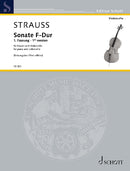| 作曲者 | Richard Strauss (1864-1949)・リヒャルト・シュトラウス |
| タイトル | Sonate F-Dur (First edition of 1st version) |
| サブタイトル | für Klavier und Violoncello / for piano and violoncello |
| 出版社 | Schott・ショット |
| 楽器編成 | cello and piano |
| 品番 | 979-0-001-21166-6 |
| 校訂者 | Florence Eller・Andreas Pernpeintner・Stefan Schenk |
| 難易度 | advanced |
| 形状 | 80 ページ・330 g・Saddle-wire stitching |
| 演奏時間 | 26' |
| 作曲年 | 1881 |
| 出版年 | 2020-02-11 00:00:00 +0900 |
| 出版番号 | CB 301 |
| ISMN | 979-0-001-21166-6 |
The Cello Sonata Op. 6 was composed over an apparently frequently interrupted period of three years, an extraordinarily long time for Strauss’s early creative phase. The compositional process spawned two independent versions of the work, the first of which is published for the first time on the basis of the text in the Critical Edition of the Works of Richard Strauss in the current edition as a practical musical text. The genesis of the two versions and the reasons for revision can only be reconstructed in part: only one of the surviving autographs bears a date and the second version only survives in printed form. What is more, Strauss did not communicate in greater detail on this composition in correspondence with his family and friends. There are enormous differences between the two versions of the Sonata: Strauss deleted the entire second and third movements Larghetto and Allegro vivace, replacing them with a newly composed Andante and Finale. In the first movement, Allegro con brio, Strauss retained the thematic-motivic material and compositionally complex passages such as the three-voice fugue in the development section (from bar 241 in the first version and bar 275 in the second version) almost intact in the new version of the sonata, but also undertook extensive alterations, particularly in the structure of the piano part, the motivic-thematic development of the movement and its harmony which became far more ambitious.12 Particular attention should be drawn to the repetitive accompaniment of the con espressione theme beginning in bar 32 and the significantly shorter development in the first version. The current printed edition of the first version of Richard Strauss’s Cello Sonata now makes it possible to follow Strauss’s compositional development during this period. The significance of the differences between the versions also mean that two sonata compositions for violoncello and piano by Richard Strauss with fundamental disparities in their underlying character are now available for performance. (from the foreword by the editors)



